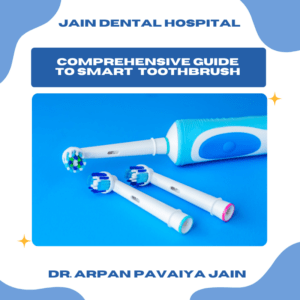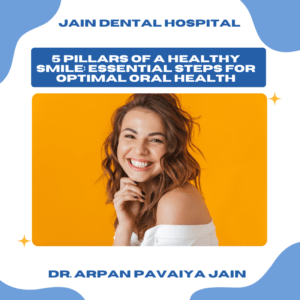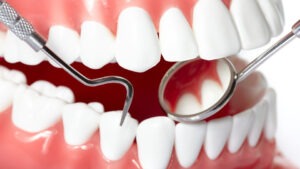Top 5 Toothpaste Myths Debunked
Toothpaste plays a crucial role in maintaining oral hygiene and promoting overall dental health.
As one of the most essential tools in our daily oral care routine, it not only helps to clean teeth and freshen breath but also provides protective benefits against cavities, gum disease, and tooth sensitivity.
The right toothpaste can enhance the effectiveness of brushing by delivering active ingredients that strengthen enamel, fight bacteria, and combat plaque buildup, but there are many misconceptions surrounding its effectiveness.
From the amount of fluoride it should contain to the color and flavour, there are countless myths that have circulated about toothpaste.
With a wide variety of formulations available, understanding the importance of long-term impact of toothpaste on our oral health and on our brighter, healthier smile is of utmost importance
In this blog post, we will debunk five common myths related with toothpaste and provide you with the facts you need to make informed choices about your oral care.
Myth 1: The More Fluoride in toothpaste, the Better it is.
First, let’s understand what is fluoride and what are its benefits in toothpaste, and the risks of too much fluoride in toothpaste
Fluoride is a natural mineral. It plays a vital role in preventing cavities by enhancing the strength and resilience of tooth enamel, making it more resistant to acid attacks from bacteria.
When we consume sugary foods and beverages, bacteria in the mouth produce acids that can erode enamel, leading to tooth decay.
Fluoride helps to counteract this process through a mechanism known as remineralization, where it aids in the repair of early decay by replenishing lost minerals in the enamel.
Additionally, fluoride interferes with the ability of bacteria to produce acids, thereby reducing the overall risk of cavities.
Its effectiveness has led to widespread use in dental products, including toothpaste and mouth rinses, as well as in community water fluoridation programs, making it one of the most effective preventive measures against dental caries.
The recommended fluoride concentration in toothpaste varies slightly depending on the age and location of the individual.
However, most dental health organizations recommend a fluoride concentration between 1000 and 1500 parts per million (ppm) for adults and children over the age of six.
For young children under the age of six, it is recommended to use toothpaste having low concentrations of fluoride, typically around 500 ppm according to guidelines of dental organizations such as American Dental Association (ADA) and the Centres for Disease Control and Prevention (CDC).
Potential Risks of Excessive Fluoride Exposure in Toothpaste
While fluoride is essential for preventing cavities, consuming too much fluoride toothpaste can lead to several potential side effects, primarily centered around dental fluorosis and other health concerns.
Dental fluorosis is a condition that causes white spots or streaks on the teeth or discoloration on the enamel of the teeth, often as a result of excessive fluoride intake during the critical period of tooth development, mostly in children under the age of six.
It is important to note that dental fluorosis is primarily a cosmetic concern and does not typically affect the function of the teeth.
However, severe cases of dental fluorosis can lead to skeletal fluorosis which can cause weakened bones and joints and increased susceptibility to cavities.
To avoid the risk of dental fluorosis, it is important to follow the recommended fluoride levels in toothpaste and to consult with your dentist if you have any concerns about your child’s fluoride intake.
Myth 2: More Toothpaste Means More Cleanliness
A common misconception among many individuals is that using a large amount of toothpaste will result in cleaner teeth. However, dental professionals emphasize that this is not a complete and accurate case.
While toothpaste is an essential component of oral hygiene, the amount you use does not directly correlate with the effectiveness of your cleaning.
The primary function of toothpaste is to deliver fluoride to your teeth, which in turn helps in the removal of plaque and food particles from the teeth.
Using more than necessary toothpaste does not significantly improve this process.
The amount of toothpaste you use does not significantly impact the amount of fluoride that reaches your teeth.
Using too much toothpaste can lead to several drawbacks.
First, it may encourage swallowing excess fluoride, which can be harmful, especially for young children. This can increase the risk of dental fluorosis, a condition that causes discoloration of the teeth.
Second, using too much toothpaste can create excess foaming, which can make it difficult to brush thoroughly and reach all the crevices of your mouth.
It may also lead to waste, as many people tend to squeeze out more than they need, resulting in unnecessary consumption and expense.
The key to effective oral hygiene lies not in the quantity of toothpaste used but in the technique of brushing, and the regularity of dental care practices.
Using a soft-bristled toothbrush and brushing for at least two minutes twice a day is far more important than the quantity of toothpaste.
Additionally, flossing and using mouthwash can help to remove plaque and bacteria from areas that a toothbrush cannot reach.
Therefore, it is unnecessary to use an excessive amount of toothpaste to achieve clean and healthy teeth.
By focusing on proper brushing techniques, flossing, and using mouthwash, you can ensure that your oral hygiene routine is effective, regardless of the amount of toothpaste you use.
Myth 3: Whitening Toothpaste Can Replace Professional Treatments
A prevalent myth in the realm of oral care is the belief that whitening toothpaste can deliver results comparable to professional whitening treatments.
While whitening toothpastes can help to brighten your smile, but they are not a substitute for professional teeth whitening treatments.
Many consumers are drawn to the promise of brighter smiles and stain removal offered by various whitening toothpaste products.
Assuming that these formulations can effectively replicate the results achieved through professional dental procedures. However, this myth overlooks the fundamental differences between the two approaches to teeth whitening.
Whitening toothpastes primarily work by using mild abrasives and chemical agents to gently remove surface stains caused by food, beverages, and tobacco and polishing the enamel to improve their appearance, but they cannot penetrate the deeper layers of the teeth to address intrinsic stains or discoloration.
In contrast, professional whitening treatments, such as in-office bleaching or at-home kits prescribed by a dentist typically use higher concentrations of bleaching agents like hydrogen peroxide or carbamide peroxide.
These bleaching agents can penetrate the tooth structure and provide a more significant change to tooth color and help in lighten the teeth significantly.
These treatments are often necessary for individuals with deep-seated stains or discoloration caused by factors such as age, certain medications, or excessive coffee or tea consumption.
Furthermore, the effectiveness of whitening toothpaste varies widely among brands and formulations, and results can often be subtle and gradual.
For individuals those are seeking dramatic improvements in tooth whiteness, then whitening toothpaste can be a helpful adjunct to professional treatments, but relying solely on whitening toothpaste for achieving a brighter smile may lead to disappointment.
Additionally, overuse of whitening products can sometimes lead to tooth sensitivity or enamel erosion, further complicating the issue.
Therefore, while whitening toothpaste can be a helpful addition to an oral hygiene routine, but they should never be viewed as a substitute for professional whitening treatments.
For those looking for significant whitening results, consulting with a dental professional is the best course of action to achieve a brighter smile safely and effectively.
Myth 4: Natural Toothpaste Are Always Better
The growing popularity of natural products has extended to oral care, with many consumers opting for natural toothpaste.
The belief that natural toothpastes are inherently superior to their conventional counterparts is a widespread myth that can lead to misguided choices in oral care.
Many consumers are drawn to the allure of “natural” or “organic” labels, assuming that these products are always safer and more effective for their dental health.
However, it’s important to understand that “natural” does not always equate to “better” regarding oral health.
Whether the toothpaste is natural or not, individuals should never neglect the indispensable role of fluoride in preventing cavities and maintaining overall oral health.
Fluoride is a mineral that has been extensively studied and proven to strengthen tooth enamel, making it more resistant to decay.
Most traditional toothpastes contain fluoride, which helps to remineralize enamel and reduce the risk of cavities.
In contrast, natural toothpaste may contain fluoride, while others may rely on alternative ingredients.
It’s crucial to choose a toothpaste that contains fluoride, otherwise, it can leave users vulnerable to dental caries, especially if they have a history of tooth decay or are at higher risk for cavities.
While natural toothpastes often contain beneficial ingredients such as essential oils and herbal extracts, they may lack the scientific backing that fluoride has for cavity prevention.
Some natural products may also contain abrasive substances that can wear down enamel over time, further compromising dental health.
Furthermore, the term “natural” can be misleading, as it doesn’t necessarily guarantee the absence of harmful chemicals.
Many do not undergo the same rigorous testing and quality control as conventional toothpaste, which can lead to inconsistencies in their performance.
Moreover, the effectiveness of natural toothpaste can vary widely, and not all are created equal.
Therefore, while natural toothpaste can be a good option for individuals with specific sensitivities or preferences, but it should not be viewed as a blanket replacement for fluoride-containing toothpaste.
The most important factor in choosing a toothpaste is ensuring that it contains fluoride and is effective in preventing cavities.
It is essential that individuals should evaluate their oral health needs and consult with dental professionals to ensure they are using products that effectively support their dental health.
Prioritizing fluoride-containing toothpaste remains a critical aspect of effective oral hygiene, particularly for those prone to cavities.
Myth 5: Toothpaste Color Matters
A common myth surrounding toothpaste is the belief that the color of the paste itself—whether it is white, blue, green, red, or any other hue—indicates the quality or effectiveness of the product.
Many consumers assume that the color reflects specific ingredients or benefits, such as natural components, whitening agents, or even the presence of fluoride.
However, the color of toothpaste is primarily a cosmetic feature and it has little to no impact on its ability to clean teeth and prevent cavities.
The reality behind the color of toothpaste is primarily a result of the formulation and the inclusion of various ingredients, such as flavoring agents, abrasives, or natural pigments extracted from plants.
For instance, blue or green toothpaste often contains added colorants to enhance visual appeal, while white toothpaste may be formulated with specific abrasives or fluoride without the need for additional coloring.
The color does not inherently signify the effectiveness or safety of the toothpaste.
Moreover, many effective toothpastes are available in a range of colors, and the presence of color does not correlate with the toothpaste’s ability to clean teeth, prevent cavities, or promote oral health.
The active ingredients that contribute to these benefits—such as fluoride, calcium carbonate, or baking soda—are effective regardless of the color of the paste.
To make informed choices about toothpaste, individuals should focus on understanding the actual ingredients of toothpaste rather than the color of the paste.
Key ingredients to look for include:
- Fluoride: Essential for strengthening tooth enamel and preventing cavities.
- Abrasives: Such as silica or calcium carbonate, which help remove plaque and surface stains.
- Humectants: Like glycerol, which prevent the paste from drying out.
- Flavoring agents: To provide a pleasant taste without added sugars.
- Surfactants: Such as sodium lauryl sulfate, which create foam and assist in cleaning.
The myth that the color of toothpaste signifies its effectiveness or quality is unfounded.
The color of the paste is determined by the formulation and the specific ingredients used, rather than by any inherent properties that would affect its performance.
Individuals should prioritize reading ingredient labels and selecting toothpaste based on their dental needs, such as cavity prevention or sensitivity relief.
Conclusion
While toothpaste plays a vital role in oral hygiene, it’s important to debunk the myths surrounding its use.
The effectiveness of toothpaste lies not in its color, quantity, or type, but in its ability to deliver fluoride and other essential ingredients to your teeth.
Remember, the key to healthy teeth is a combination of factors, including regular brushing, flossing, a balanced diet, and regular dental check-ups.
By following these guidelines and choosing a toothpaste that suits your needs, you can enjoy a lifetime of healthy, beautiful teeth.
Get the Facts About Smart Toothpaste!
Confused about toothpaste? Jain Dental Hospital is here to help you separate fact from fiction. Schedule a consultation today to discuss your oral hygiene routine and get personalized recommendations for the best toothpaste for your needs. Call us at +91-9582535204 or visit our website at www.jaindentistdelhi.com to book your appointment online. We look forward to seeing you smile!

Dr. Arpan Pavaiya Jain, Director of Jain Dental Hospital, Indirapuram, Ghaziabad is a renowned Prosthodontist and Implantologist with over 20 years of expertise in advanced dentistry. A graduate of the prestigious King George’s Medical College Lucknow, he has performed more than 20,000 successful dental implant procedures. Dr. Jain leads a team of skilled professionals, offering state-of-the-art treatments in dental implants, clear aligners, cosmetic dentistry, orthodontics, and more. Known for his personalized care and commitment to excellence, he has earned a reputation as a trusted dental expert in Indirapuram, Ghaziabad.





